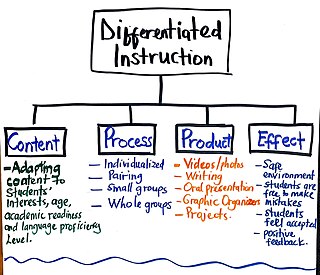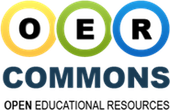A didactic method is a teaching method that follows a consistent scientific approach or educational style to present information to students. The didactic method of instruction is often contrasted with dialectics and the Socratic method; the term can also be used to refer to a specific didactic method, as for instance constructivist didactics.

Open educational resources (OER) are freely accessible, openly licensed instructional materials such as text, media, and other digital assets that are useful for teaching, learning, and assessing, as well as for research purposes.
A learning management system (LMS) is a software application for the administration, documentation, tracking, reporting, automation, and delivery of educational courses, training programs, or learning and development programs. The learning management system concept emerged directly from e-Learning. Learning management systems make up the largest segment of the learning system market. The first introduction of the LMS was in the late 1990s. Learning management systems have faced a massive growth in usage due to the emphasis on remote learning during the COVID-19 pandemic.
The Education Quality and Accountability Office (EQAO) is a Crown agency of the Government of Ontario in Canada. It was legislated into creation in 1996 in response to recommendations made by the Royal Commission on Learning in February 1995.
Educational technology is the combined use of computer hardware, software, and educational theory and practice to facilitate learning. When referred to with its abbreviation, edtech, it is often referring to the industry of companies that create educational technology.

Learning Object Metadata is a data model, usually encoded in XML, used to describe a learning object and similar digital resources used to support learning. The purpose of learning object metadata is to support the reusability of learning objects, to aid discoverability, and to facilitate their interoperability, usually in the context of online learning management systems (LMS).
The Individualized Education Program (IEP) is a legal document under United States law that is developed for each public school child in the U.S. who needs special education. It is created through a team of the child's parent(s) and district personnel who are knowledgeable about the child's needs. IEPs must be reviewed every year to keep track of the child's educational progress.
Technology integration is the use of technology tools in general content areas in education in order to allow students to apply computer and technology skills to learning and problem-solving. Generally speaking, the curriculum drives the use of technology and not vice versa. Technology integration is defined as the use of technology to enhance and support the educational environment. Technology integration in the classroom can also support classroom instruction by creating opportunities for students to complete assignments on the computer rather than with normal pencil and paper. In a larger sense, technology integration can also refer to the use of an integration platform and APIs in the management of a school, to integrate disparate SaaS applications, databases, and programs used by an educational institution so that their data can be shared in real-time across all systems on campus, thus supporting students' education by improving data quality and access for faculty and staff.
"Curriculum integration with the use of technology involves the infusion of technology as a tool to enhance the learning in a content area or multidisciplinary setting... Effective integration of technology is achieved when students are able to select technology tools to help them obtain information in a timely manner, analyze and synthesize the information, and present it professionally to an authentic audience. The technology should become an integral part of how the classroom functions—as accessible as all other classroom tools. The focus in each lesson or unit is the curriculum outcome, not the technology."

A school library is a library within a school where students, staff, and often, parents of a public or private school have access to a variety of resources. The goal of the school library media center is to ensure that all members of the school community have equitable access "to books and reading, to information, and to information technology." A school library media center "uses all types of media... is automated, and utilizes the Internet [as well as books] for information gathering." School libraries are distinct from public libraries because they serve as "learner-oriented laboratories which support, extend, and individualize the school's curriculum... A school library serves as the center and coordinating agency for all material used in the school."

David A. Wiley is an American academic, writer who is the chief academic officer of Lumen Learning, education fellow at Creative Commons, and former adjunct faculty of instructional psychology and technology at Brigham Young University, where he was previously an associate professor. Wiley's work on open content, open educational resources, and informal online learning communities has been reported in many international outlets, including The New York Times, The Hindu, MIT Technology Review, and Wired. Wiley was also previously a member of the advisory committee of University of the People.
An open-source curriculum (OSC) is an online instructional resource that can be freely used, distributed and modified. OSC is based on the open-source practice of creating products or software that opens up access to source materials or codes. Applied to education, this process invites feedback and participation from developers, educators, government officials, students and parents and empowers them to exchange ideas, improve best practices and create world-class curricula. These "development" communities can form ad-hoc, within the same subject area or around a common student need, and allow for a variety of editing and workflow structures.

Knowledge Ontario was a non-profit organization supporting a number of related province-wide initiatives in Ontario, Canada, providing library and information resources, learning experiences and related services to people across all ages, locations, education levels and cultural institutions. Knowledge Ontario comprised five projects: Ask Ontario, Connect Ontario, Learn Ontario, Our Ontario and Resource Ontario, as well as the eResources Portal, which was launched in 2010. Knowledge Ontario has ceased operations, effective December 31, 2012.

Differentiated instruction and assessment, also known as differentiated learning or, in education, simply, differentiation, is a framework or philosophy for effective teaching that involves providing all students within their diverse classroom community of learners a range of different avenues for understanding new information in terms of: acquiring content; processing, constructing, or making sense of ideas; and developing teaching materials and assessment measures so that all students within a classroom can learn effectively, regardless of differences in their ability. Differentiated instruction, according to Carol Ann Tomlinson, is the process of "ensuring that what a student learns, how he or she learns it, and how the student demonstrates what he or she has learned is a match for that student's readiness level, interests, and preferred mode of learning." According to Boelens et al. (2018), differentiation can be on two different levels: the administration level and the classroom level. The administration level takes the socioeconomic status and gender of students into consideration. At the classroom level, differentiation revolves around content, processing, product, and effects. On the content level, teachers adapt what they are teaching to meet the needs of students. This can mean making content more challenging or simplified for students based on their levels. The process of learning can be differentiated as well. Teachers may choose to teach individually at a time, assign problems to small groups, partners or the whole group depending on the needs of the students. By differentiating product, teachers decide how students will present what they have learned. This may take the form of videos, graphic organizers, photo presentations, writing, and oral presentations. All these take place in a safe classroom environment where students feel respected and valued—effects.
A virtual learning environment (VLE) in educational technology is a web-based platform for the digital aspects of courses of study, usually within educational institutions. They present resources, activities, and interactions within a course structure and provide for the different stages of assessment. VLEs also usually report on participation; and have some level of integration with other institutional systems.

Twig Education is a digital media company that offers education content to schools via subscription websites.

OER Commons is a freely accessible online library that allows teachers and others to search and discover open educational resources (OER) and other freely available instructional materials.
Mashups are a combination of two or more data sources that have been integrated into one source. They typically consist of graphics, texts, audio clips, and video that have been sourced from various media such as blogs, wikis, YouTube, Google Maps, etc., into a new product. Remix is a related term, referring to how data sources have been combined to produce a constellation of elements that were not originally intended by the creators. Mashups rely on open and discoverable resources, open and transparent licensing, and open and remixable formats.
OpenEd is an online catalog of educational assessments, homework assignments, videos, games and lesson plans aligned to every Common Core standard and several other standards, and includes the only open source formative item bank. The site offers the ability for teachers to assign resources to their students online, letting students take assessments, do homework etc on their own computers or tablets. Assignments done online are graded automatically and presented to the teacher in a mastery chart. OpenEd's slogan mentions "assessment to instruction" meaning, formative assessments given on OpenEd can access OpenEd's large catalog on a per student basis to recommend the right resource to each student individually. The company has stated that functionality of searching the site and most of its resources are free and will continue to be free going forward. However, the company is also distributing premium content from publishers such as Pearson and Houghton Mifflin Harcourt to teachers for $9.95 per month.
A learning cell is a learning strategy for a pair of students to learn together. Its is an active learning style. A learning cell is a process of learning where two students alternate asking and answering questions on commonly read materials.
Open educational resources in Canada are the various initiatives related to open education, open educational resources (OER), open pedagogies (OEP), open educational practices (OEP), and open scholarship that are established nationally and provincially across Canadian K-12 and higher education sectors, and where Canadian based inititatives extend to international collaborations.